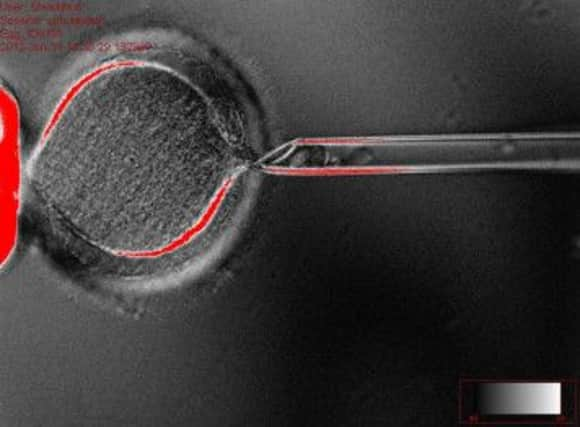Scientists use skin to create stem cells


The advance, described as a “milestone”, is expected to aid the development of stem cell therapies that avoid using fertilised human embryos.
However, as the method employs a cloning technique, it is certain to fuel controversy over so-called “Brave New World” science, a reference to the 1931 Aldous Huxley novel in which children are “hatched”.
Advertisement
Hide AdAdvertisement
Hide AdThe US scientists involved in the process say they are not interested in cloning humans, and in any case do not believe their methods could successfully be used in this way.
However, the therapeutic cloning technique they employed would also be the start of the process of making duplicate humans.
It is the first time scientists have managed to create human embryos through cloning developed enough to provide stem cells.
The same somatic cell nuclear transfer (SCNT) technique was employed by researchers at the Roslin Institute in Edinburgh to produce Dolly the Sheep in 1996, the first mammal to be cloned from an adult cell.
During SCNT, a donor cell nucleus is transferred to an egg cell whose own DNA has been removed. The egg develops into an early-stage embryo that is a clone of the donor.
Stem cells taken from the embryo have the ability – with coaxing – to mature into any kind of body tissue.
In the new study, reported in the journal Cell, scientists transferred nuclei from human skin cells into human egg cells.
They generated early embryos consisting of a cluster of 150 cells, from which human embryonic stem cells were obtained and grown in the laboratory.
Advertisement
Hide AdAdvertisement
Hide AdLead researcher Professor Shoukhrat Mitalipov, from Oregon Health and Science University in the US, said: “Our finding offers new ways of generating stem cells for patients with dysfunctional or damaged tissues and organs.
“Such stem cells can regenerate and replace those damaged cells and tissues and alleviate diseases that affect millions of people.”
The stem cells demonstrated an ability to convert into several different cell types, including nerve, liver and heart cells.
Prof Mitalipov added: “Furthermore, because these reprogrammed cells can be generated with nuclear genetic material from a patient, there is no concern of transplant rejection.
“While there is much work to be done in developing safe and effective stem cell treatments, we believe this is a significant step forward in developing the cells that could be used in regenerative medicine.”
Prof Mitalipov spelled out the distinction between therapeutic cloning, the technique used in his research, and reproductive cloning.
He doubted that the same method could be used to clone human babies.
He added: “Our research is directed toward generating stem cells for use in future treatments to combat disease.
Advertisement
Hide AdAdvertisement
Hide Ad“While nuclear transfer breakthroughs often lead to a public discussion about the ethics of human cloning, this is not our focus, nor do we believe our findings might be used by others to advance the possibility of human reproductive cloning.”
Drug offers cancer hope
A NEW leukaemia drug might offer “hope” to many patients who have nowhere left to turn, claims a cancer charity.
Leukaemia and Lymphoma Research said obinutuzumab might give patients “effective, life-prolonging treatment”.
The drug appears to be “more effective” than another monoclonal antibody – a medication that harnesses the body’s immune system to target cancer cells – which is used alongside chemotherapy to treat chronic lymphocytic leukaemia.
Manufacturer Roche said the drug can “reduce the risk of cancer worsening or death by up to 86 per cent” when used with chemotherapy, against chemo alone.